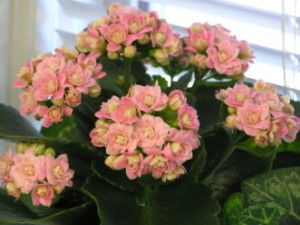The island of Madagascar, off the coast of Africa, is home to all kinds of interesting plants and animals. My favorites among the fauna are lemurs, primates that have adapted successfully to even the harshest environments. There is something especially endearing about the ring-tailed lemurs, which hold their long tails optimistically aloft while roaming through southern Madagascar.
Kalanchoe, being a plant, is more rooted than the average lemur, but is also native to Madagascar. You have probably seen kalanchoe, specifically Blossfeld’s kalanchoe or Kalanchoe blossfeldiana, in a garden center, nursery or grocery store near you. Though the plants are available year-round, right now they are decked out in holiday wrappings. Kalanchoe are not as traditional as poinsettias for holiday decorating and gift giving, but have grown in popularity over the last twenty-five or so years.
The glossy green leaves are fleshy, as befits succulent plants, and nicely scalloped. Sometimes the edges have a reddish tint, which adds interest between flowering periods. The kalanchoe that are commercially available right now have been “forced” in greenhouses to ensure holiday bloom. Those blooms are eye-catching, in colors that run the gamut from white, through shades of pink, red, orange and yellow. Traditionally the plants have umbels–flat-topped clusters–of small, single flowers that rise above the foliage. Sometimes retailers carry a kalanchoe variety with the trade name “Kalandiva”, which features umbels of double flowers that contribute to a more opulent, diva-like appearance.
Kalanchoe belongs to the large and varied Crassulaceae family, and are related to another popular indoor stalwart, the jade plant. The vogue for kalanchoe fits nicely with the current fashion for other kinds of succulents. Unlike some of its succulent relatives, kalanchoe has showy blooms and a very long flowering period.
Many holiday plants, like paperwhites and poinsettias, are meant to be ephemeral, but kalanchoe is easy to keep and care for. With a modicum of effort, it will bloom again eventually, most likely in spring. After the flowers fade, position the container in a sunny windowsill. Like other succulents, kalanchoe thrives with relatively little water. When you do apply the watering can, make sure the top of the soil is dry. Take a look at the leaves. If they are plump and firm, the plant may not need water at all. If they seem flaccid, water sparingly. In spring, the kalanchoe should start active growth once again, so begin feeding with a balanced fertilizer, applied according to package directions. Like many houseplants, it appreciates an outdoor vacation in the warm weather. This should not happen until night temperatures are consistently above fifty degrees Fahrenheit. When the plant goes outside, place it in a protected spot, as wind can topple it over and damage the branching stems.
If those stems grow “leggy”, with relatively few leaves compared to the length of the stem, pinch the stems back by about one third. This promotes branching and increases flower production.
As lovely as kalanchoe is on its own, it also plays well with others in container arrangements. As with any other living situation, the best way to ensure wellbeing is to combine the kalanchoe with other plants that have the same needs, including free draining soil, bright light and limited moisture. Other types of succulents fill the bill perfectly. If you have a large jade plant, kalanchoe might grow nicely at its feet. Conversely, a single kalanchoe might be the central plant in a large round container filled with lower-growing succulents. The advantage to these mixed container arrangements is that the relatively floriferous kalanchoe helps compensate for the minimal flowering habits of some of its fellow succulents.
If, like me, you dream of someday visiting Madagascar, buy a kalanchoe to help keep the dream alive. You can even go one step further and hang a picture of a ring-tailed lemur somewhere nearby.

